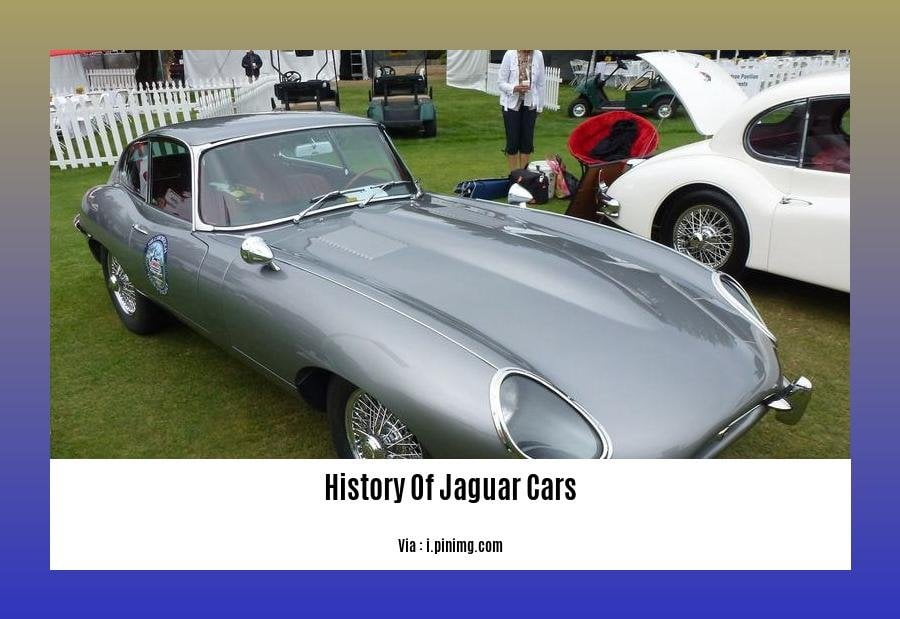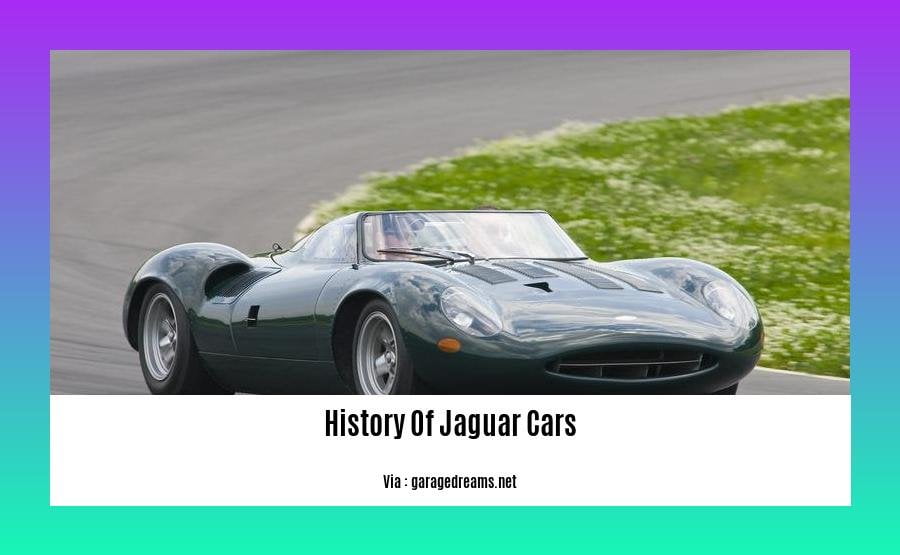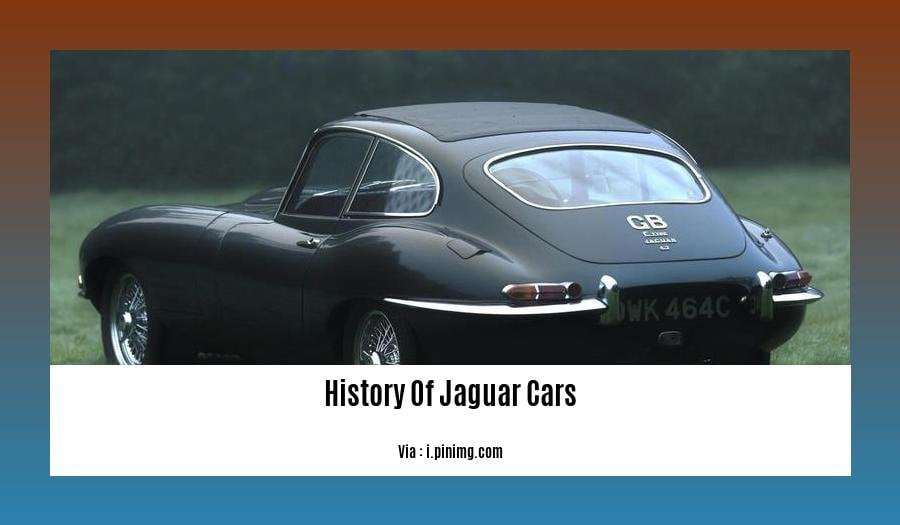Delve into the captivating narrative of Jaguar cars, a journey that epitomizes automotive excellence. From its humble beginnings in a humble Coventry workshop to its reign as a symbol of British luxury and performance, Jaguar’s story is a testament to innovation, elegance, and a relentless pursuit of perfection. Join us as we embark on a voyage through time, exploring the iconic models, legendary triumphs, and enduring legacy that have cemented Jaguar’s place in the automotive pantheon: [A Journey Through Excellence: Unraveling the History of Jaguar Cars].
Key Takeaways:
Jaguar Cars, a British multinational car manufacturer, is the luxury vehicle brand of Jaguar Land Rover, headquartered in Whitley, Coventry, England.
The Swallow Sidecar Company, the predecessor to Jaguar, was founded by William Lyons and William Walmsley in 1922.
The first car to bear the Jaguar name was the SS 2½-litre sports saloon in 1935.
In 1945, the company officially changed its name to Jaguar Cars Limited.
Jaguar has had remarkable success in sports car racing, especially at the Le Mans 24 Hours, winning in 1951, 1953, 1955, 1956, 1957, 1988, and 1990.
The Jaguar E-Type, introduced in 1961, is widely considered one of the most iconic sports cars of all time.
Jaguar Land Rover merged with Tata Motors of India in 2008.
History of Jaguar Cars

From humble beginnings as the Swallow Sidecar Company to becoming an iconic British luxury car manufacturer, Jaguar has left an enduring mark on the automotive landscape. This article takes you on a captivating journey through Jaguar’s rich history, exploring the milestones, models, and innovations that have shaped its legacy.
The Early Years: Pioneering Spirit
The story of Jaguar begins in 1922 when William Lyons and William Walmsley joined forces to establish the Swallow Sidecar Company. Initially focused on crafting motorcycle sidecars, the company soon expanded into car production, showcasing an innovative spirit that would define its future.
The Birth of Jaguar: A New Era Begins
In 1935, the SS 2½-litre sports saloon marked a pivotal moment, becoming the first car to bear the Jaguar name. With its sleek styling and impressive performance, the SS 100, introduced in 1936, further solidified Jaguar’s reputation for excellence.
Post-War Triumphs: Racing Legacy and the Iconic E-Type
The post-World War II era heralded a golden age for Jaguar, with the company achieving remarkable success in sports car racing. Victories at the prestigious Le Mans 24 Hours endurance race in 1951, 1953, 1955, 1956, and 1957 cemented Jaguar’s status as a force to be reckoned with on the track.
1961 witnessed the birth of the legendary Jaguar E-Type, a car that would go on to become an automotive icon. With its breathtaking design and blistering speed, the E-Type captivated the world, earning accolades as one of the most beautiful cars ever produced.
Modern Era: Navigating Change and Innovation
The latter half of the 20th century saw Jaguar facing challenges and changes, including the oil crisis of the 1970s and transitions in ownership. Despite these obstacles, the brand remained committed to innovation, introducing models like the XJ6 and the XK8 that upheld its reputation for luxury and performance.
The 21st Century: A New Chapter Under Tata Motors
In 2008, Jaguar’s journey took a new turn when it became part of Tata Motors, India’s largest automotive manufacturer. This partnership brought fresh investment and strategic direction, leading to the development of new models like the F-Type sports car and the I-Pace, Jaguar’s first all-electric vehicle.
Jaguar Today: Embracing the Future
Today, Jaguar stands as a global luxury brand, renowned for its distinctive designs, cutting-edge technology, and exhilarating driving experience. As the world transitions towards electrification, Jaguar is poised to lead the charge, with a commitment to producing a range of fully electric vehicles by 2025.
Conclusion: A Legacy of Excellence
Throughout its illustrious history, Jaguar has consistently pushed the boundaries of automotive design and performance, leaving an indelible mark on the industry. From the early days of sidecar manufacturing to the modern era of electric vehicles, Jaguar’s unwavering commitment to excellence continues to inspire and captivate enthusiasts worldwide.
Wondering about the reign of the Italian rulers in Bengal? Take a quick trip to the history of the dynasty by clicking on the history of Itachuna Rajbari.
Immerse yourself in the melodious tunes and rhythmic beats of the Italian legacy in the history of Italian music.
From priceless gems to dazzling diamonds, unravel the fascinating journey of ornamentation through the ages in the history of jewellery.
In 1935, SS Cars changed its name to Jaguar due to negative associations with Nazi Germany.
In a world filled with iconic automotive brands, Jaguar stands out as a symbol of elegance, performance, and innovation. But do you know the story behind the company’s name change from SS Cars to Jaguar in 1935?
Let’s dive into the intriguing history:
- A Name with Unfortunate Connotations:
In the early days of the 20th century, William Lyons and William Walmsley founded a company called Swallow Sidecar Company. Lyons, a passionate automotive enthusiast, later ventured into car production and adopted the initials SS for Swallow Sidecar. Little did they know that these initials would become unintentionally associated with the infamous Nazi SS troops.
- The Need for a Change:
As the Nazi regime gained power in Germany, the negative connotations associated with the SS name became increasingly apparent. The company realized that it could not continue using a name that had such dark and sinister undertones.
- The Birth of Jaguar:
To distance itself from the Nazi SS, the company decided to change its name. After careful consideration, they settled on Jaguar, inspired by the grace, power, and agility of the big cat. The name perfectly encapsulated the essence of their automobiles, which were known for their sleek designs and exhilarating performance.
- A New Beginning:
With the adoption of the Jaguar name, the company embarked on a new chapter in its history. The SS Cars era was officially over, and the Jaguar brand was born. This bold move not only shed the negative associations but also ushered in a period of growth and success for the company.
Key Takeaways:
Unforeseen Consequences: The original name, SS Cars, inadvertently created a connection to the Nazi SS troops, leading to negative associations.
A Name Change for Survival: The company recognized the importance of shedding the SS name to protect its reputation and ensure its continued success.
Inspired by Nature: The choice of Jaguar as the new name was influenced by the animal’s grace, power, and agility, qualities that aligned with the brand’s vehicles.
A New Chapter Begins: The name change marked a fresh start for the company, allowing it to move forward with a positive identity.
Sources:
Jaguar gained recognition for its SS 100 sports car, which showcased the company’s commitment to performance and style.

In the annals of automotive history, Jaguar occupies a prominent position, renowned for its legacy of innovation, elegance, and exhilarating performance. Among the pantheon of iconic models that shaped the brand’s illustrious journey, the Jaguar SS 100 stands as a pivotal creation, embodying the essence of Jaguar’s unwavering commitment to pushing boundaries and redefining the standards of automotive excellence.
The Jaguar SS 100, unveiled in 1936, marked a watershed moment for the British automaker. This sleek and powerful sports car showcased Jaguar’s mastery of engineering and design, setting new benchmarks for performance and style.
A Masterpiece of Engineering and Design:
- Striking Design:
The Jaguar SS 100 captivated hearts with its aerodynamic silhouette, characterized by flowing lines, a long hood, and a distinctive grille that exuded both elegance and aggression.
High-Performance Engine:
Beneath the hood of the SS 100 resided a meticulously crafted 2.5-liter engine, capable of generating an impressive output of 100 horsepower. This potent powerplant, coupled with a lightweight chassis, propelled the car to a remarkable top speed of 100 miles per hour.
Advanced Suspensions and Brakes:
Handling and stability were paramount for the Jaguar SS 100. To achieve these qualities, the car featured a sophisticated suspension system comprising half-elliptical springs and rigid axles, ensuring a smooth and controlled ride even at high speeds. Additionally, hydraulic brakes provided reliable stopping power, enhancing the overall safety of the vehicle.
Luxurious Interior:
- Inside the Jaguar SS 100, occupants were greeted by a luxurious and well-appointed cabin. Premium leather upholstery, plush carpeting, and a spacious layout created an environment of comfort and refinement, complementing the car’s exhilarating performance.
The Road to Recognition:
The Jaguar SS 100 quickly gained recognition and acclaim for its exceptional qualities. Here are some highlights of its impact on the automotive world:
- Racing Success:
The Jaguar SS 100 proved to be a formidable competitor on the racetrack, showcasing its prowess in various events. In 1937, the SS 100 achieved a remarkable victory at the prestigious Le Mans 24 Hours race, further solidifying Jaguar’s reputation as a force to be reckoned with in the world of motorsports.
Popular Demand:
The Jaguar SS 100 resonated with driving enthusiasts worldwide, generating significant demand. Its combination of performance, style, and exclusivity made it a highly sought-after commodity, with production initially struggling to keep pace with the overwhelming customer interest.
Legacy of Innovation:
- The Jaguar SS 100 laid the foundation for Jaguar’s unwavering commitment to innovation. Its advanced engineering and design solutions became the blueprint for future Jaguar models, shaping the brand’s identity as a pioneer in automotive technology.
Key Takeaways:
The Jaguar SS 100 was produced between 1936 and 1939 as a range of sports roadsters.
It had a top speed of 100 MPH and could reach 60 MPH in 10.5 seconds.
The Jaguar SS 100 achieved remarkable success in racing, including a victory at the 1937 Le Mans 24 Hours.
The car’s popularity and demand led to it becoming a highly sought-after commodity, cementing Jaguar’s reputation for excellence.
The Jaguar SS 100 set the stage for Jaguar’s legacy of innovation and cutting-edge automotive technology.
[Sources:]
Throughout the 1950s and 1960s, Jaguar produced iconic models like the XK120, E-Type, and Mark II, solidifying its status as a manufacturer of elegant and powerful cars.
In the world of automotive excellence, Jaguar stands as a beacon of elegance, power, and innovation. This legendary British brand has crafted a rich tapestry of iconic vehicles that have left an indelible mark on the automotive landscape.
During the 1950s and 1960s, Jaguar’s design prowess and engineering brilliance reached new heights. It was an era that witnessed the birth of some of the most celebrated models in the company’s history, propelling Jaguar to the forefront of the automotive world.
At the heart of this golden age lay the Jaguar XK120. Unveiled in 1948, this breathtaking sports car set the standard for post-war performance. Powered by a potent 3.4-liter straight-six engine, the XK120 could effortlessly reach speeds of over 100 miles per hour, earning it the title of the world’s fastest production car.
Not content to rest on its laurels, Jaguar followed up with the legendary E-Type in 1961. This masterpiece of design and engineering stunned the world with its sleek silhouette, innovative features, and blistering performance. The E-Type quickly became a symbol of the Swinging Sixties, capturing the hearts and imaginations of enthusiasts worldwide.
Alongside these sports car icons, Jaguar also left an indelible mark on the luxury sedan segment with the Mark II. Introduced in 1959, the Mark II was a revolutionary vehicle that redefined the concept of a sports sedan. Combining refined elegance with exhilarating performance, the Mark II became a favorite among discerning drivers seeking both luxury and speed.
These three models, the XK120, E-Type, and Mark II, epitomized Jaguar’s commitment to excellence and innovation. They not only cemented the brand’s reputation as a manufacturer of elegant and powerful cars but also left a lasting legacy that continues to inspire and captivate generations of automotive enthusiasts.
Key Takeaways:
- The 1950s and 1960s marked a golden era for Jaguar, characterized by the production of iconic models like the XK120, E-Type, and Mark II.
- The Jaguar XK120, introduced in 1948, was a groundbreaking sports car that held the title of the world’s fastest production car.
- The Jaguar E-Type, unveiled in 1961, captivated the world with its stunning design, innovative features, and exhilarating performance.
- The Jaguar Mark II, launched in 1959, redefined the concept of a sports sedan, combining elegance, luxury, and speed.
- These iconic models cemented Jaguar’s reputation as a manufacturer of elegant and powerful cars, leaving a lasting legacy that continues to inspire automotive enthusiasts worldwide.
Sources:
FAQ
Q1: What were the key milestones in the early history of Jaguar Cars?
A1: The pivotal moments include the foundation of the Swallow Sidecar Company in 1922, the introduction of the SS 2½-litre sports saloon in 1935, and the official name change to Jaguar Cars Limited in 1945.
Q2: What are some of Jaguar’s most notable achievements in motorsports?
A2: Jaguar has a rich history in motorsports, particularly in endurance racing. The brand achieved seven victories at the prestigious 24 Hours of Le Mans, with triumphs in 1951, 1953, 1955, 1956, 1957, 1988, and 1990.
Q3: Which Jaguar model is widely regarded as one of the most iconic sports cars of all time?
A3: The Jaguar E-Type, introduced in 1961, holds a special place in automotive history. Its combination of stunning design, impressive performance, and cultural significance earned it the reputation as one of the most iconic sports cars ever produced.
Q4: When did Jaguar become part of Tata Motors?
A4: Jaguar’s journey as part of Tata Motors commenced in 2008 when the Indian automotive giant acquired Jaguar Land Rover, the parent company of Jaguar Cars. This merger marked a significant chapter in Jaguar’s history, bringing it under the umbrella of one of the world’s largest automotive conglomerates.
Q5: What was the significance of the Jaguar SS 100?
A5: The Jaguar SS 100, produced between 1936 and 1939, holds a special place in Jaguar’s history. It was the first model to bear the Jaguar name and showcased the company’s commitment to blending performance and style. The SS 100 achieved remarkable success, establishing Jaguar’s reputation for producing exceptional sports cars.
- Crypto Quotes’ Red Flags: Avoid Costly Mistakes - June 30, 2025
- Unlock Inspirational Crypto Quotes: Future Predictions - June 30, 2025
- Famous Bitcoin Quotes: A Deep Dive into Crypto’s History - June 30, 2025
















